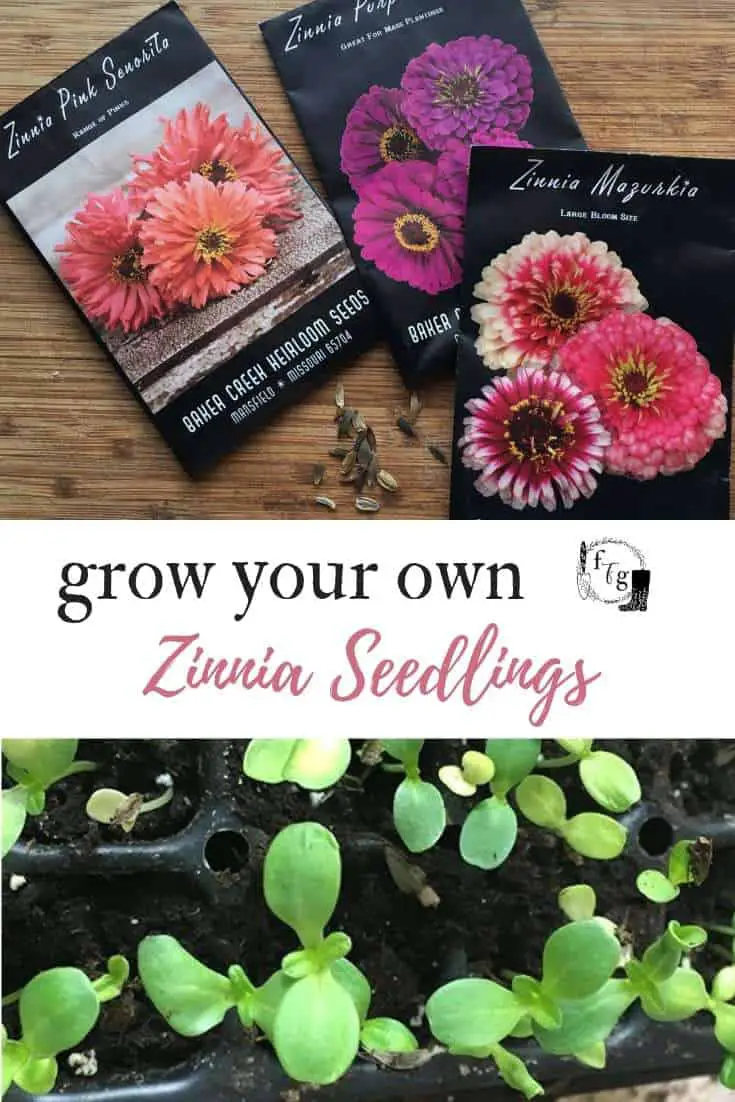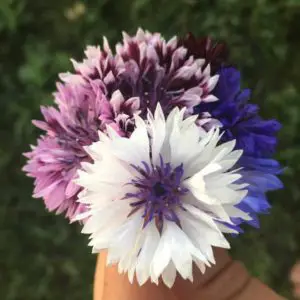Zinnias are annual summer flowers that originated in Mexico and other areas of South and Central America. These daisy-type flowers are found in a variety of bold colors, including red, orange, pink, purple, yellow, and white, and they have hundreds of tiny petals surrounding a yellow-bordered central disc.
Zinnia plants grow to between 12 and 39 inches tall, depending on the variety. The plants grow seasonally in all zones.
Types of Zinnias

There are more than 20 species of zinnia flowers in the wild. Only some of these species are grown in gardens, but many have been bred to produce hundreds of different hybrids and cultivars — there are zinnias of all colors and sizes available to grow in your backyard.
Most cultivated species originate from the species Zinnia elegans, which has a black and yellow central disc surrounded by purple petals. Single-flowered zinnias have a single row of petals. Double-flowered zinnias have numerous rows of petals. Semi-double-flowered zinnias are a cross between the single- and double-flowered varieties. There are also different zinnia shapes, like “button,” “beehive,” and “cactus.”
Some of the most popular varieties of zinnias are:
- Big red: Grow to 24–36 inches tall with 6-inch scarlet blossoms. Popular due to their fast growth and large flower heads
- California giant: Grow to 30–40 inches tall with 6-inch blossoms in shades of red, pink, yellow, and orange. Popular due to their large size and beginner-friendly growth
- Dahlia flowered mix: Grow to 24–36 inches tall with 5-inch blossoms in rose, lilac, purple, orange, scarlet, coral, and yellow colors. Popular due to their resemblance to dahlias and their fast growth
- Crystal: Grow to 6–12 inches tall with 1–2-inch blossoms in shades of yellow and white. Popular due to their daisy-like appearance and extended blooming time
When to Plant Zinnias
The best time to plant zinnias is in the late spring, when the soil is warm and the last frost has passed. Ideally, plant your zinnias directly into well-draining soil in a location that receives at least eight hours of full sun.
Zinnias prefer to be planted directly into the garden bed rather than being transplanted. However, if planting straight into the ground isn’t possible, plant zinnia seedlings in a potting mix in containers in late May. Wait for the seedlings to develop three full sets of leaves before transplanting the flowers into a large outdoor pot or into the ground.
Growing Zinnias From Seeds

Zinnia seeds can be grown in a pot or planted directly into the soil. If you choose to plant seeds in a pot, make sure there’s enough room in the pot for the plants to grow. One zinnia plant needs, at minimum, a 6-inch pot.
Planting Zinnias in the Soil
Zinnias grow best when seeded directly into the ground instead of being transplanted because direct seeding avoids the risk of root damage. To plant zinnias in the soil, follow these steps:
- Wait to plant until spring, when the last frost has passed
- Choose a suitable location for planting the seeds. Avoid shaded locations that block out the sunlight
- Test, and if necessary, adjust your soil’s pH. Zinnias prefer a soil pH of between 5.5 and 7.5. Limestone can be used to raise soil pH, and peat moss or pine needles can lower pH
- Plant zinnia seeds ¼-inch deep in the soil, leaving at least 3 inches between each seed
- Fertilize the soil weekly to encourage the zinnias to bloom all season
Sowing Zinnia Seeds Undercover
To start zinnias in your house under cover in order to transplant them later, follow these steps:
- Fill a seed tray or small pots with seed compost
- Water the compost gently until it’s damp to touch, then press the seeds into the soil, leaving 3 inches between each seed
- Place the pots or trays on a warm windowsill that gets at least six hours of full sunlight, with a room temperature of between 68°F and 75°F
- Transplant the seedlings into outdoor pots or into your garden once the seedlings have formed two or three sets of leaves
Planting Zinnias in Pots
Zinnias can be sown directly into outdoor pots when ground soil isn’t available. To plant seeds in pots, follow these steps:
- Fill one or several containers with commercial potting mix. Wait to plant until two weeks after the last frost has passed
- Water the compost until it becomes damp, then plant the seeds. Zinnias spread to about 1.5 feet, so plant one zinnia in a 6-inch pot or up to five zinnias in a 14-inch pot
- Place the pots in full sunlight
- Fertilize the plants weekly to encourage the zinnias to bloom all season
Caring for Growing Zinnias

To care for zinnias that are growing in your backyard, water the soil when the top inch feels dry to touch. Fertilize the soil once a week to keep the flowers blooming throughout the season.
Keep the plants tidy and encourage long stem growth and lots of blooms by pinching off flowers as they die. When the plants reach a height of between 8 and 12 inches, snip the top 3 to 4 inches off the plants with sharp pruners.
Saving Zinnia Seeds
Zinnia seeds can be saved for next year’s planting. To save your seeds, wait for your zinnia flower heads to become brown and crisp in late summer. Cut your chosen flowerhead and bring it inside, then break open the flowerhead and sprinkle the seeds over a screen, and leave the seeds on the screen in a cool, dark location for two weeks to dry. The dry seeds can be moved to an airtight container and stored in a dark cupboard away from heat or humidity until the following spring.
Pests and Diseases
There are several pests and diseases that are known to affect zinnias:
- Powdery mildew, fungal and bacterial spots, and bacterial wilt: Produce white, fuzzy spots on the leaves and stems of plants. Prevent these diseases by properly spacing zinnias seeds and preventing waterlogged soil
- Mealybugs, caterpillars, and spider mites: Cause leaf damage and affect the appearance of zinnias. Tackle an infestation of pests by spraying the plants with a commercial pesticide
FAQs About Zinnia

Here, you’ll find the answers to common questions about zinnias.
Are Zinnias Perennial?
No, zinnias aren’t perennial — they’re annuals, which means they need to be re-sown from seed every year. Perennial plants regrow every spring, but annual plants like zinnias die off after one full growing season. If you prefer perennial plants, consider dahlias, which look similar to zinnias and grow for many years without being re-sown.
How Tall Do Zinnias Grow?
Zinnias grow to between 10 inches and 4 feet tall, depending on the zinnia variety. The shortest variety is the dwarf zinnia, which grows as tall as 10 inches. One of the tallest varieties is Benary’s giant zinnia, which grows to more than 4 feet tall. To get the longest stems from your zinnias, pinch the plants (remove the tender, new growth at the end of the main stem) when they’re young.
Do Zinnias Self-Seed?
Yes, zinnias self-seed by developing flowers and then dropping their seeds into the soil. However, the likelihood of the seeds germinating and growing the following spring is slim. Most likely, the seeds will be eaten by birds and bugs or damaged by the frost over winter. To enjoy your zinnias year after year, collect the seeds from the soil and store them in an airtight container in a cool, dark cupboard until it’s time to plant them.
Are Zinnias Poisonous to Dogs and Cats?
No, zinnias aren’t poisonous to dogs or cats. However, your pet shouldn’t excessively eat zinnias because this could cause an upset stomach. Most animals don’t eat lots of these plants, but puppies and kittens may eat too many. Supervise young pets while they play near garden plants to ensure the pets don’t eat poisonous plants.







I’m a Wii Fit Trainer main